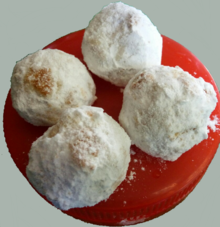Kue makmur (Malay: kuih makmur, Jawi: معمور; Bruneian Malay: kuih mor) is a traditional Malay kue or kuih. This cake made from nuts in a powder form, ghee, flour and icing sugar. Its availability is limited to the bazaars of the month-long Ramadhan, and it is served to guests for Eid al-Fitr. Kue makmur is identified with its white colour and usually in a round shape.[1]
 | |
| Alternative names | Kuih makmur |
|---|---|
| Type | Cake, pastry, kue |
| Course | Snack, dessert |
| Place of origin | Brunei, Indonesia, Malaysia and Singapore |
| Region or state | Southeast Asia |
| Created by | Malays |
| Serving temperature | room temperature |
| Main ingredients | Nuts, ghee, flour and icing sugar |
History
editThe origin of kue makmur is somewhat uncertain and believed to be derived from the Middle Eastern ma'amoul that was introduced by Arab merchants throughout the Malay Archipelago. Since then, kue makmur has been a part of the traditional kue or kuih of Brunei, Indonesia, Malaysia and Singapore. In 2015, kue makmur was featured in a series of Singaporean stamps.[2] Loosely translated, they would be called "prosperous biscuits (UK)/cookies (US)".
See also
editReferences
edit- ^ Rahimy Rahim (8 June 2017). "Traditional kuih makmur gets a makeover". The Star. Retrieved 4 July 2017.
- ^ Rachel Tan (24 March 2015). "Traditional biscuits to be featured in new stamp series". The Straits Times. Retrieved 4 July 2017.